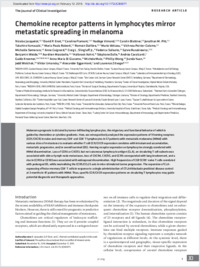Chemokine receptor patterns in lymphocytes mirror metastatic spreading in melanoma
- Jacquelot, Nicolas INSERM U1015, Gustave Roussy Cancer Campus, Villejuif, France - University Paris-Saclay, Kremlin Bicêtre, France - Gustave Roussy Cancer Campus, Villejuif, France
- Enot, David P. Gustave Roussy Cancer Campus, Villejuif, France - Metabolomics and Cell Biology Platforms, Gustave Roussy Cancer Campus, Villejuif, France
- Flament, Caroline INSERM U1015, Gustave Roussy Cancer Campus, Villejuif, France - Gustave Roussy Cancer Campus, Villejuif, France - CIC Biotherapie IGR Curie, CIC1428, Gustave Roussy Cancer Campus, Villejuif, France
- Vimond, Nadège Gustave Roussy Cancer Campus, Villejuif, France - CIC Biotherapie IGR Curie, CIC1428, Gustave Roussy Cancer Campus, Villejuif, France - Laboratory of Immunomonitoring in Oncology (LIO), UMS 3655 CNRS, US 23 INSERM, Gustave Roussy Cancer Campus, Villejuif, France
- Blattner, Carolin Skin Cancer Unit, German Cancer Research Center (DKFZ), Heidelberg, Germany - Department of Dermatology, Venereology and Allergology, University Medical Center Mannheim, Ruprecht-Karl University of Heidelberg, Mannheim, Germany
- Pitt, Jonathan M. INSERM U1015, Gustave Roussy Cancer Campus, Villejuif, France - Gustave Roussy Cancer Campus, Villejuif, France
- Yamazaki, Takahiro INSERM U1015, Gustave Roussy Cancer Campus, Villejuif, France - Gustave Roussy Cancer Campus, Villejuif, France
- Roberti, María Paula INSERM U1015, Gustave Roussy Cancer Campus, Villejuif, France - Gustave Roussy Cancer Campus, Villejuif, France
- Daillère, Romain INSERM U1015, Gustave Roussy Cancer Campus, Villejuif, France - University Paris-Saclay, Kremlin Bicêtre, France - Gustave Roussy Cancer Campus, Villejuif, France
- Vétizou, Marie INSERM U1015, Gustave Roussy Cancer Campus, Villejuif, France - Gustave Roussy Cancer Campus, Villejuif, France
- Poirier-Colame, Vichnou INSERM U1015, Gustave Roussy Cancer Campus, Villejuif, France - Gustave Roussy Cancer Campus, Villejuif, France
- Semeraro, Michaëla INSERM U1015, Gustave Roussy Cancer Campus, Villejuif, France - Center of Clinical Investigation, Hôpital Necker Enfants Malades, Paris, France
- Caignard, Anne INSERM U1016, CNRS UMR8104, Cochin Institute, Paris, France
- Slingluff Jr., Craig L. Division of Surgical Oncology, Department of Surgery, University of Virginia, Charlottesville, Virginia, USA
- Sallusto, Federica Institute for Research in Biomedicine (IRB), Faculty of Biomedical Sciences, Università della Svizzera italiana, Switzerland
- Rusakiewicz, Sylvie INSERM U1015, Gustave Roussy Cancer Campus, Villejuif, France - Gustave Roussy Cancer Campus, Villejuif, France - CIC Biotherapie IGR Curie, CIC1428, Gustave Roussy Cancer Campus, Villejuif, France
- Weide, Benjamin Eberhard Karls Universität Tübingen, Department of Immunology, Tübingen, Germany - University Medical Center Tübingen, Department of Dermatology, Tübingen, Germany
- Marabelle, Aurélien INSERM U1015, Gustave Roussy Cancer Campus, Villejuif, France - Gustave Roussy Cancer Campus, Villejuif, France - CIC Biotherapie IGR Curie, CIC1428, Gustave Roussy Cancer Campus, Villejuif, France
- Kohrt, Holbrook Division of Oncology, Department of Medicine, Stanford University, Stanford, California, USA
- Dalle, Stéphane Centre Hospitalier Lyon-Sud, Cancer Research Center of Lyon and University Claude Bernard Lyon 1, Lyon, France
- Cavalcanti, Andréa Gustave Roussy Cancer Campus, Villejuif, France
- Kroemer, Guido Gustave Roussy Cancer Campus, Villejuif, France - Metabolomics and Cell Biology Platforms, Gustave Roussy Cancer Campus, Villejuif, France - Equipe 11 Labellisée par la Ligue contre le Cancer, Centre de Recherche des Cordeliers, Paris, France - INSERM, U1138, Paris, France - Université Paris Descartes, Sorbonne Paris Cité, Paris, France - Université Pierre et Marie Curie, Paris, France - Pôle de Biologie, Hôpital Européen Georges Pompidou, AP-HP, Paris, France
- Di Giacomo, Anna Maria Medical Oncology and Immunotherapy Division, University Hospital of Siena, Viale Bracci, Siena, Italy
- Maio, Michele Medical Oncology and Immunotherapy, Department of Oncology, University Hospital of Siena, Istituto Toscano Tumori, Siena, Italy
- Wong, Phillip Ludwig Center for Cancer Immunotherapy, Department of Immunology and Department of Medicine, Memorial Sloan-Kettering Cancer Center, New York, New York, USA
- Yuan, Jianda Ludwig Center for Cancer Immunotherapy, Department of Immunology and Department of Medicine, Memorial Sloan-Kettering Cancer Center, New York, New York, USA
- Wolchok, Jedd Ludwig Center for Cancer Immunotherapy, Department of Immunology and Department of Medicine, Memorial Sloan-Kettering Cancer Center, New York, New York, USA
- Umansky, Viktor Skin Cancer Unit, German Cancer Research Center (DKFZ), Heidelberg, Germany - Department of Dermatology, Venereology and Allergology, University Medical Center Mannheim, Ruprecht-Karl University of Heidelberg, Mannheim, Germany
- Eggermont, Alexander Gustave Roussy Cancer Campus, Villejuif, France
- Zitvogel, Laurence INSERM U1015, Gustave Roussy Cancer Campus, Villejuif, France - University Paris-Saclay, Kremlin Bicêtre, France - Gustave Roussy Cancer Campus, Villejuif, France - CIC Biotherapie IGR Curie, CIC1428, Gustave Roussy Cancer Campus, Villejuif, France
-
08.02.2016
Published in:
- The journal of clinical investigation. - 2016, vol. 126, no. 3, p. 921-937
English
Melanoma prognosis is dictated by tumor-infiltrating lymphocytes, the migratory and functional behavior of which is guided by chemokine or cytokine gradients. Here, we retrospectively analyzed the expression patterns of 9 homing receptors (CCR/CXCR) in naive and memory CD4+ and CD8+ T lymphocytes in 57 patients with metastatic melanoma (MMel) with various sites of metastases to evaluate whether T cell CCR/CXCR expression correlates with intratumoral accumulation, metastatic progression, and/or overall survival (OS). Homing receptor expression on lymphocytes strongly correlated with MMel dissemination. Loss of CCR6 or CXCR3, but not cutaneous lymphocyte antigen (CLA), on circulating T cell subsets was associated with skin or lymph node metastases, loss of CXCR4, CXCR5, and CCR9 corresponded with lung involvement, and a rise in CCR10 or CD103 was associated with widespread dissemination. High frequencies of CD8+CCR9+ naive T cells correlated with prolonged OS, while neutralizing the CCR9/CCL25 axis in mice stimulated tumor progression. The expansion of CLA-expressing effector memory CD8+ T cells in response to a single administration of CTLA4 blockade predicted disease control at 3 months in 47 patients with MMel. Thus, specific CCR/CXCR expression patterns on circulating T lymphocytes may guide potential diagnostic and therapeutic approaches.
- Language
-
- English
- Classification
- Medicine
- License
- Open access status
- gold
- Identifiers
-
- RERO DOC 324430
- DOI 10.1172/JCI80071
- ARK ark:/12658/srd1318955
- Persistent URL
- https://n2t.net/ark:/12658/srd1318955
Statistics
Document views: 144
File downloads:
- Texte intégral: 218
